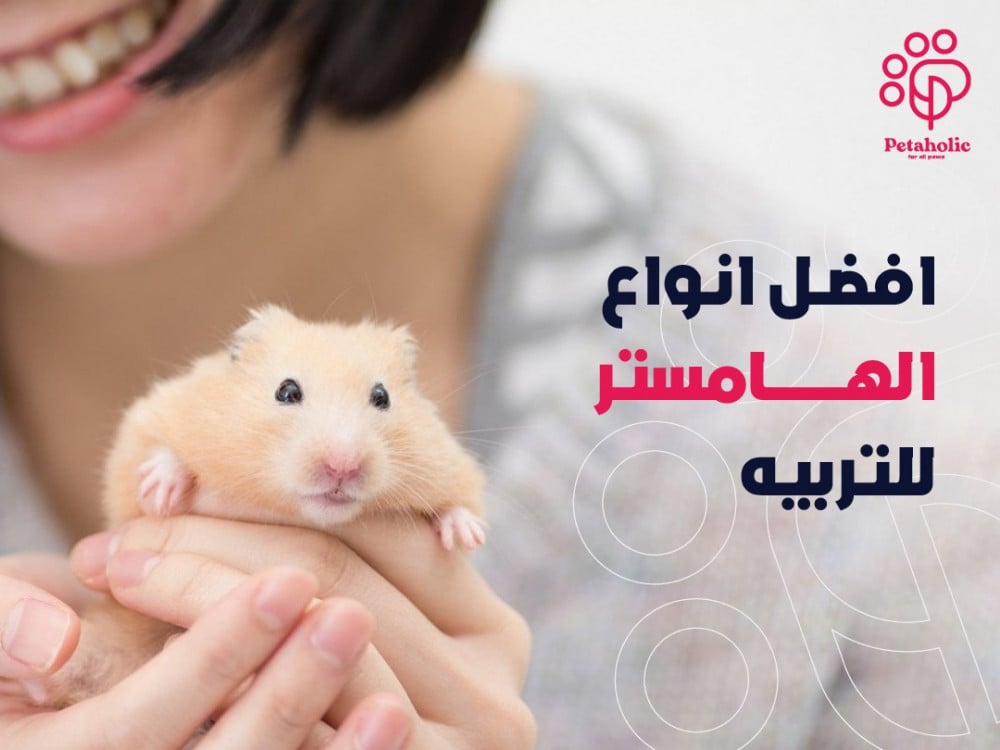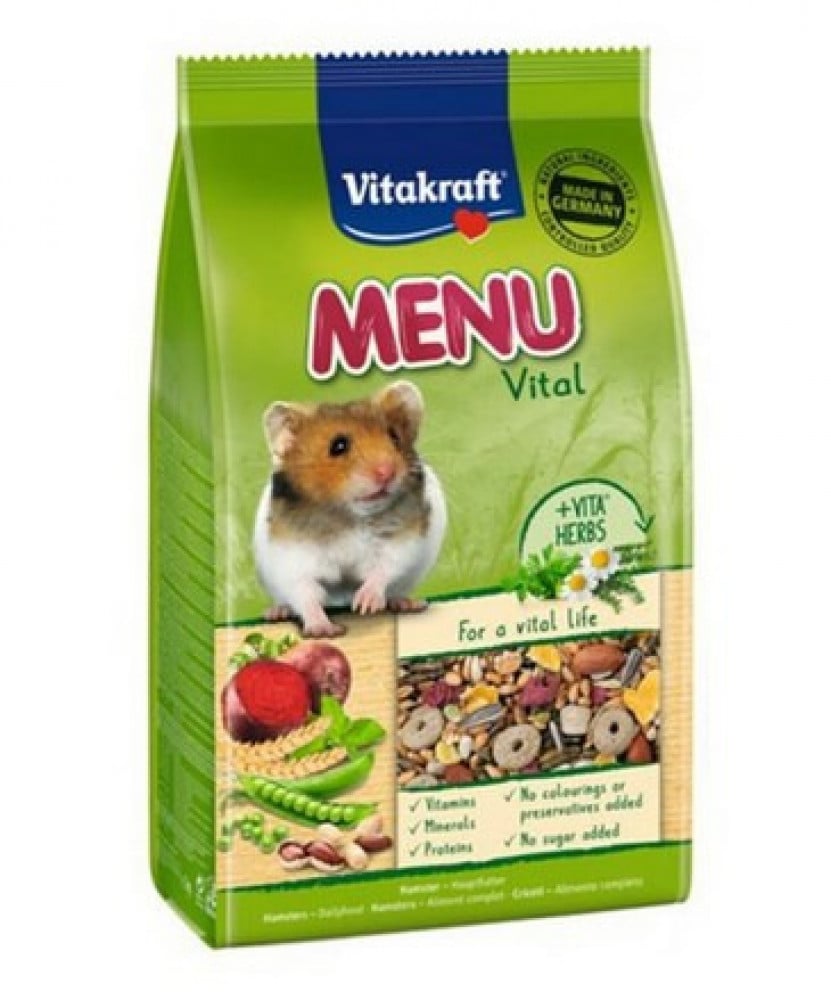
Hamsters are a popular pet for beginners and children as they are easy to care for, but you may find it difficult to choose between the variety of breeds available. Each breed is a little different, and the best hamster breed just depends on what you're personally looking for. Therefore, we present to you in the following lines the best types of hamsters for home raising for beginners. You will also find in our distinguished store, Petaholic, all the high-quality hamster supplies to make the task of raising him easier for you.
What are the best types of hamsters for home raising for beginners?
The best types of hamsters for breeding are as follows:
Syrian hamster
One of the most popular types of hamsters is the Syrian hamster, also known as the golden hamster. It is very popular in the market and due to its friendly nature is ideal for beginners. Syrian hamsters are very easy to tame, and are fun to be around and play with as well. There is also another reason why it is ideal for beginners, which is that it is a pet that requires little care.
You can take care of a Syrian hamster easily, and it is easy to provide it with habitats because it does not need a large space to live. In addition, it is small in size and easy to handle and keep. You'll just need to make sure he doesn't have any problems living inside a cage and do regular checkups to make sure he doesn't have any health issues.
Dwarf hamster
The dwarf hamster is an amazing little hamster that can be kept as a pet for beginners. The best part about this is that the dwarf hamster is a nocturnal pet; Which means he will be awake during dawn and dusk. But as time passes, the dwarf hamster will be able to adapt to its owners' schedule, which will be good for both the owner and the hamster; Because they will have the same time to wake up and sleep. Just make sure you provide him with all the things he needs, all of which you will find available in our store, Petaholic.
Rubovski's hamster
Robovski hamsters are one of the smallest and fastest types of hamsters, and because of their size, they are easy to handle and care for, but they are still sensitive in nature, so care must be taken with them. This type is very active in nature and owners can never get bored with them; Because these amazing animals will keep them entertained. They are also nocturnal by nature, and also since they are very active, you need to provide them with plenty of toys to play with, and in a hurry so that they can do something without getting stressed or bored. Since you can't be with your Robovski hamster all the time, this is the best way to keep him busy. It looks very cute and has great features, and even kids love it. The only thing you need to keep in mind is that you need to be nice to him so that he does not fear you.
Chinese hamsters are one of the best types of hamsters to raise at home
The Chinese hamster is a small hamster, and as the name suggests, it originates from China. They have long tails compared to other breeds of hamsters, and you need to make sure that they do not face any problems when they live with their owners. They make good pets, and are also calm when someone handles them. Make sure that you understand your Chinese hamster properly so that you can provide it with proper care and also let it be what it is. Don't force him into anything because he also has an aggressive nature sometimes. You also need to provide him with toys and wheels so that he can stay busy and enjoy his time inside the cage.
Among our special products that we offer for all hamsters at Petaholic, we recommend that you purchase:
Important tips for dealing with hamsters properly
Although the species of hamster can determine how friendly it is, there are other factors that are more important. For example, the more you handle your hamster, the more comfortable it will be to hold. So, take your hamster out of the cage and spend some quality time with it if you want to raise a friendly hamster of your own. Here are the most basic tips for dealing with all types of hamsters:
- Wash your hands well before handling it, as hamsters use their sense of smell to detect potential threats and identify potential food sources. If your hamster smells a cat scent on you, or smells something that it thinks is food, it may bite you as a way to recognize the smell, and this may happen even with the best types of hamsters to raise at home.
- Let him wake up properly alone for the first time. Waking your hamster may cause him to become frightened, which is a sure reason for a bite.
- When you want to insert your hand into the cage, place it flat on the bottom of the cage for a short while. This indicates that you are not a threat.
- Let the hamster come to you. If you grab it in a pincer-like motion, it will look like a predator. The hamster's natural defense in this case is to bite you in an attempt to drive you away.
- You can use positive reinforcement to train your hamster to relax in your hand. The first few times you hold him, reward him with a treat he enjoys. After several rewards, your hamster will associate your hand with the positive experience of receiving a small reward, and will look forward to it.
- Keep animals and even small children away from your hamster at first. Dogs and cats can get very excited, and are usually fascinated by the little animal running around on your hand. If your hamster gets scared, it may bite you or it may try to jump out of your hand and end up injuring itself.
- Take things slowly. Once your hamster feels comfortable holding it and sitting in your hand a few inches from the floor of the cage, you can begin to take it out of the cage, keeping it comfortable to hold and ensuring it doesn't get hurt if it decides to jump up and run.
Among the delicious foods in Petaholic for hamsters that we advise you to use as rewards to stimulate your hamster and strengthen the relationship between you:
How do I know the type of hamster?
There are several types of hamsters, and they vary in sizes, colors, and behaviors. Here are some traits you can consider to determine the type of hamster:
1. Syrian hamster (fat):
- Also known as the golden hamster.
- Its size is larger than the Russian hamster.
- The fur color is varied and can have different patterns.
- Males are larger than females.
- They live alone due to their solitary nature.
2. Russian hamster (winter):
- Its size is smaller than the Syrian hamster.
- They have a thick patch of fur above the back that resembles the color scheme of autumn winter.
- People with social personalities may live together on the condition that they are raised together from a young age.
3. Chinese hamster:
- It is medium in size and looks very similar to a Russian hamster.
- The scalp is dark in color and the back and body are light in color.
- They have social personalities and can live together similar to Russian hamsters.
4. Cambodian hamster:
- Its size is larger than the Syrian hamster.
- Their scalp is light in color and their body is dark in color.
- They are characterized by a longer fur around the neck.
When choosing a hamster, be sure to check with your pet store or breeder for additional information about the type of hamster and proper care for it.
Is it permissible to raise hamsters at home?
According to Islamweb.ne t
This animal mentioned in the question: the hamster - has a mention in the Arabic Encyclopedia and the Free Encyclopedia and is known in the Arabic language as Qaddad, and its plural is Qaddad. It is not a mouse, even if it resembles it as a jerboa and a hyrax resemble it. If that is the case and this animal is not a mouse, then there is nothing wrong with it. Raising him, unlike the mouse, is not permissible to raise him. Rather, he is one of the immoral people that we have been commanded to kill.
How do I know that a hamster is happy?
There are several signs that your hamster may be happy and content. Here are some signs to watch for:
1. Activity and play: If your hamster is active and engages in play and entertainment, it is a positive sign. You can provide toys and accessories to check his response to them.
Learn about the various types of cages from Petaholic. Shop now from here
2. Nutrition and weight: If he eats well and maintains a healthy weight, this is an indication of his happiness. Check the quality of the food and make sure to provide him with a variety of his favorite foods.
3. General appearance and shine of the fur: A happy hamster often appears with clean, shiny fur. Make sure the fur is clean and free of lice or ticks.
4. Good sleep: A healthy sleep pattern indicates a happy hamster. Providing a quiet and safe place to sleep helps achieve this.
5. Positive interaction: If he interacts positively with you when you interact with him, this means that he trusts you and feels safe.
6. Cage cleanliness: A clean and tidy cage contributes to the happiness of the hamster.
Clean the cage regularly to provide a healthy environment.
7.Sounds and whistles: Your hamster may make happy sounds or soft whistles when it is feeling well.
Are hamsters a type of rat?
No, hamsters are not a type of rat, but rather a type of rodent belonging to the hamsteridae family. Hamsters are a small genus of rodents, which includes several different species. Hamsters are known for their small size and services as a popular pet.
The hamster is distinguished by its small body, and has thick fur surrounding its body. It includes some well-known species of hamsters, such as the Syrian hamster, Russian hamster, and Chinese hamster.
Although there is some suspicion in the name, hamsters are not considered part of the rat family. Both hamsters and mice are unique species of rodents, differing in behavior, nutrition, and needs.
Now that you are familiar with the best hamster breeds for beginners, the key with all types is to try to understand them and provide them with the best of everything. This way your hamster can live a happy life. At Petaholic, you can get all the supplies for your hamster to provide the healthy, comfortable life they deserve.
Read also:-
- Are hamsters easy to handle and care for?
- Tips for raising hamsters: how to clean them and the reasons for their hair loss




